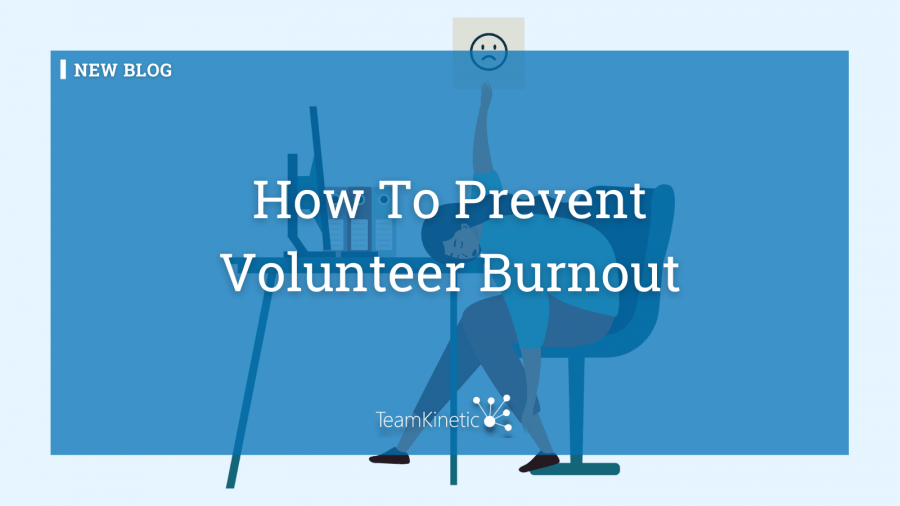What is Burnout?
Burnout is typically associated with the workplace, however, it frequently happens to volunteers. The World Health Organization (WHO) defines burnout as “a syndrome conceptualised as resulting from chronic workplace stress that has not been successfully managed”. WHO characterises it by three dimensions:
- Feelings of exhaustion.
- Increased mental distance from one’s job and/or feelings of negativism about one’s job.
- Reduced professional efficacy.

A negative impact may include your volunteers speaking negatively about the work your organisation does. This can discourage other volunteers from wanting to get involved with the organisation in the future. If burnt-out volunteers continue to show up for their shifts, their overall productivity will most likely decrease.
Surprisingly, too much volunteering can be a bad thing. Burnout in volunteers can lead to people feeling unmotivated, which leaves volunteers resenting their work. Burnout can be recognised and managed. However, if left untreated, burnout can cause volunteers to become depressed, anxious, and overwhelmed, which can harm the organisation.
Causes of Burnout
There are many causes of volunteer burnout. By identifying these causes, you can prevent burnout from happening to your volunteers. However, it is important to note that sometimes burnout can’t be avoided due to the volunteer’s mindset and lack of passion. Not every volunteer will be as passionate as the volunteer manager. Some people’s motivation levels for the organisation may differ.
If volunteers are given too much to do, they may get overwhelmed by taking on too many tasks. A poor working environment can make the volunteers feel unwelcome. It’s important to provide your volunteers with a comfortable space. This can enable them to feel settled in. Supervisors of the volunteers can give support and guidance because a lack of this can lead to the volunteers feeling lost. Volunteers may also have little knowledge of the tasks they are completing, meaning they can’t do the tasks efficiently.
Important signs to look for before burnout happens to your volunteers:
It’s key for a volunteer manager to look out for any warning signs so you can spot an unhappy volunteer before burnout occurs. The risk of burnout increases over time so it’s important to notice it before it becomes harmful.
Firstly, look out for any changes in your volunteer’s personality that could show signs of anxiousness or discomfort. For example, if a volunteer regularly spoke about their love for volunteering and had a lot of enthusiasm for your organisation’s missions, but then begins to complain and have a negative attitude, it may be an obvious sign they are no longer enjoying it.
Many volunteers are initially motivated at the beginning. Despite this, you should check up on volunteers who may feel like their work has no impact. Any motivated volunteer should believe all their hard work has a big impact on people’s lives. If your volunteers are doubting their contribution to the community, it could be a red flag to watch out for.

If volunteers aren’t performing during shifts as well as they previously were, or they’re cancelling shifts without reason, these are very clear signs of volunteer burnout. Overall, if volunteers are showing very obvious signs of lack of motivation and enthusiasm about the organisation and display a negative view of volunteering, it usually means they are about to experience burnout.
Tips to avoid burnout:
For some volunteers, burnout is unavoidable. However, here are some useful tips you can take on board as a volunteer manager to overcome burnout. It is important to remember that volunteer burnout is normal and most long-term volunteers will go through a period of burnout.
- Ensure the volunteers know what they are doing before the shift so they are fully prepared. This means there is a lower risk of a volunteer feeling lost and confused about what they are supposed to be doing. If the volunteer has a bad first shift then this could then lead to them not wanting to take part in future shifts.
- It is key to create stable working relationships with your volunteers so that you can both feel comfortable and confident around each other. A welcoming environment also enables volunteers to feel more relaxed. Providing refreshments and general support is a good idea to achieve this.
- To help build that stable working relationship, as a volunteer manager you should recognise your volunteer’s hard work and reward them. Rewards can be certificates or our rewards feature on the system which allows you to send badges to volunteers. However, it is not necessary to always hand out rewards. If volunteers are completing the work for the right reasons then a simple ‘thank you’ will be appreciated.
- Communication is crucial between you and your volunteers. This is so both parties can give feedback to improve. There is also a feedback section available on our system where volunteers can also log their hours.
- Taking time to have regular check-ins with your volunteers can help to nurture your relationship. During this time you can ask your volunteers how they are feeling about the work and therefore notice any potential red flags that may lead to burnout.
By completing these steps as a volunteer manager, you’ll have happy and healthy volunteers.
You can find TeamKinetic on social media and listen to our podcast:
Twitter Facebook LinkedIn YouTube Instagram Podcast
Have you enjoyed using TeamKinetic? If you could leave us a review on Capterra, we’d really appreciate it! We’ll even send you a little thank you.

1 Pingback